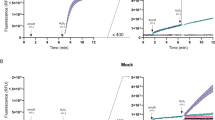Abstract
Replying to M. Schwarzländer et al. Nature 514, 10.1038/nature13858 (2014)
In the accompanying Comment1, Schwarzländer et al. challenged our recent study2 because they failed to reproduce our previous finding that the fluorescence intensity of purified circularly permuted yellow fluorescent protein (cpYFP) increases in response to oxygen and superoxide anions produced by xanthine (X) plus xanthine oxidase (XO)3. Starting from a ‘fully reduced’ state (incubation with 10 mM dithiothreitol for >3 h) and in the presence of 75 mM HEPES, we demonstrated that cpYFP exhibits a twofold fluorescence increase after oxygenation, and an additional twofold increase after the subsequent addition of X plus XO, which could not be accounted for by solvent (potassium hydroxide)-induced alkalization. Furthermore, the xanthine plus xanthine oxidase-induced increase in cpYFP fluorescence was reversed by Cu/Zn superoxide dismutase (600 U ml−1). We also found that the fluorescence intensity of fully reduced cpYFP increased >fourfold after incubation with 1 mM aldrithiol. Notably, recombinant cpYFP purified in the absence of dithiothreitol treatment exhibits a high fluorescence comparable to that of the fully oxidized state, indicating the high susceptibility of cpYFP to oxidation in non-reducing environments3. Therefore, ensuring a fully reduced state of cpYFP is essential for the probe to sense superoxide in vitro. This property is probably the reason that the probe functions readily as a reversible superoxide biosensor when targeted to the reduced environment of the mitochondrial matrix. Unfortunately, from the brief description of the methods and limited data provided by Schwarzländer et al.1, it is not possible to determine whether cpYFP was fully reduced in their experiments, or whether sufficient precautions were taken to prevent oxidation of the probe. Moreover, in our experiments cpYFP was expressed in Escherichia coli BL21(DE3)LysS cells, whereas Schwarzländer et al.1 used E. coli Origami, a trxB (thioredoxin reductase) mutant strain that also lacks glutathione reductase needed to fully limit cysteine oxidation4, which could result in an increased oxidative status of their purified cpYFP rendering it non-responsive to superoxide.
This is a preview of subscription content, access via your institution
Access options
Subscribe to this journal
Receive 51 print issues and online access
$199.00 per year
only $3.90 per issue
Buy this article
- Purchase on Springer Link
- Instant access to full article PDF
Prices may be subject to local taxes which are calculated during checkout
Similar content being viewed by others
References
Schwarzländer, M. et al. The ‘mitoflash’ probe cpYFP does not respond to superoxide. Nature 514, http://dx.doi.org/10.1038/nature13858 (2014)
Shen, E.-Z. et al. Mitoflash frequency in early adulthood predicts lifespan in Caenorhabditis elegans. Nature 508, 128–132 (2014)
Wang, W. et al. Superoxide flashes in single mitochondria. Cell 134, 279–290 (2008)
Derman, A. I., Prinz, W. A., Belin, D. & Beckwith, J. Mutations that allow disulfide bond formation in the cytoplasm of Escherichia coli. Science 262, 1744–1747 (1993)
Huang, Z. et al. Response to “A critical evaluation of cpYFP as a probe for superoxide”. Free Radic. Biol. Med. 51, 1937–1940 (2011)
Wei-LaPierre, L. et al. Respective contribution of mitochondrial superoxide and pH to mitochondria-targeted circularly permuted yellow fluorescent protein (mt-cpYFP) flash activity. J. Biol. Chem. 288, 10567–10577 (2013)
Li, K. et al. Superoxide flashes reveal novel properties of mitochondrial reactive oxygen species excitability in cardiomyocytes. Biophys. J. 102, 1011–1021 (2012)
Schwarzländer, M. et al. Pulsing of membrane potential in individual mitochondria: a stress-induced mechanism to regulate respiratory bioenergetics in Arabidopsis. Plant Cell 24, 1188–1201 (2012)
Schwarzlander, M. et al. Mitochondrial ‘flashes’: a radical concept repHined. Trends Cell Biol. 22, 503–508 (2012)
Santo-Domingo, J., Giacomello, M., Poburko, D., Scorrano, L. & Demaurex, N. OPA1 promotes pH flashes that spread between contiguous mitochondria without matrix protein exchange. EMBO J. 32, 1927–1940 (2013)
Tang, S. et al. Design and application of a class of sensors to monitor Ca2+ dynamics in high Ca2+ concentration cellular compartments. Proc. Natl Acad. Sci. USA 108, 16265–16270 (2011)
Pouvreau, S. Superoxide flashes in mouse skeletal muscle are produced by discrete arrays of active mitochondria operating coherently. PLoS ONE 5, e13035 (2010)
Zhang, X. et al. Superoxide constitutes a major signal of mitochondrial superoxide flash. Life Sci. 93, 178–186 (2013)
Azarias, G. & Chatton, J. Y. Selective ion changes during spontaneous mitochondrial transients in intact astrocytes. PLoS ONE 6, e28505 (2011)
Breckwoldt, M. O. et al. Multiparametric optical analysis of mitochondrial redox signals during neuronal physiology and pathology in vivo. Nature Med. 20, 555–560 (2014)
Hou, T. et al. Synergistic triggering of superoxide flashes by mitochondrial Ca2+ uniport and basal reactive oxygen species elevation. J. Biol. Chem. 288, 4602–4612 (2013)
Ma, Q. et al. Superoxide flashes: early mitochondrial signals for oxidative stress-induced apoptosis. J. Biol. Chem. 286, 27573–27581 (2011)
Pagliarini, D. J. et al. A mitochondrial protein compendium elucidates complex I disease biology. Cell 134, 112–123 (2008)
Hou, T., Wang, X., Ma, Q. & Cheng, H. Mitochondrial flashes: new insights into mitochondrial ROS signaling and beyond. J. Physiol. (Lond.) 592, 3703–3713 (2014)
Author information
Authors and Affiliations
Corresponding authors
Rights and permissions
About this article
Cite this article
Cheng, H., Wang, W., Wang, X. et al. Cheng et al. reply. Nature 514, E14–E15 (2014). https://doi.org/10.1038/nature13859
Published:
Issue Date:
DOI: https://doi.org/10.1038/nature13859
This article is cited by
Comments
By submitting a comment you agree to abide by our Terms and Community Guidelines. If you find something abusive or that does not comply with our terms or guidelines please flag it as inappropriate.



